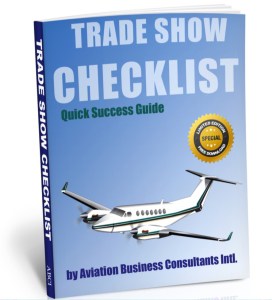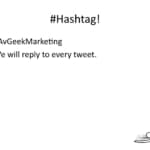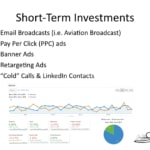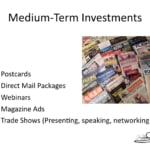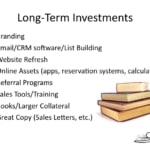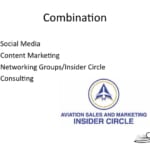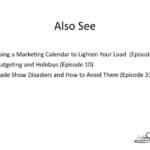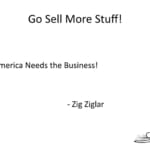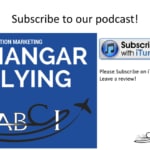Just like any smart portfolio, your aviation marketing assets should include short, medium and long-term marketing investments.
 Just like eating a balanced diet or having a balanced investment portfolio, it’s important to diversify your aviation marketing investments and activities to provide short, medium and long-term results to keep your sales pipeline healthy.
Just like eating a balanced diet or having a balanced investment portfolio, it’s important to diversify your aviation marketing investments and activities to provide short, medium and long-term results to keep your sales pipeline healthy.
Many aviation professionals mistake “marketing” for “advertising,” and spend their time and money on short-term investments that might bring in customers in the short-term, but aren’t making medium- and long-term investments like a referral program and search engine optimization.
In this podcast, we include different marketing activities that can fall into one of these three categories, and some that transcend all three categories.
Our recommendation, include at least three of each type of marketing investment in your plan!
Transcript – Short, Medium and Long-Term Marketing Investments!
Paula Williams: Welcome to aviation marketing Hangar Flying Episode number 52, Short, Medium, and Long Term Marketing Investments.
Paula Williams: So I’m Paula Williams.
John Williams: And I’m John Williams.
Paula Williams: And we are ABCI and ABCI’s mission is
John Williams: To help you folks out there sell more products and services in the aviation world.
Paula Williams: Absolutely, so there might be questions and comments and other things that come up as you listen to this and or any of our other podcasts or articles or anything like that. So you can reply on our website or on social media and just use the hashtag #AvGeekMarketing so that I will find them and make sure that we reply to ever aviation marketing question or concern.
All right. Today we’re talking about where to make investments in your marketing system and there are reasons that you don’t want to put all your eggs in one basket. Just like when your investing you don’t want to put all your eggs in one basket right, John?
John Williams: Of course.
Paula Williams: [LAUGH] All right, excuse me. The reason for that is because in marketing as in every other thing, there are some things that are going to give you immediate results and somethings that are going to take longer. And a lot of people kinda tend toward the immediate results.
And that’s almost kind of like when you eat nothing but sugar. [LAUGH] You feel really good temporarily, but then an hour later you get a headache. And as soon as the sugar high wears off you need more sugar. So you really need to have a balanced diet, if we want to put it that way, of marketing investments as well as anything else that you are doing right?
So the problem with those short term investments is they tend to be what we call random acts of marketing right? [LAUGH]
John Williams: Yes they do.
Paula Williams: So somebody calls your office and says I have a really great deal on magazine space. Or I can do an e-mail broadcast for you for a great price or whatever the situation is.
And that’s wonderful if it fits into your plan but if it doesn’t fit into your plan or even worse if you don’t have a plan then it doesn’t go so well.
John Williams: You need an integrated marketing system.
Paula Williams: Exactly, and a responsible aviation marketing company will advise you that your integrated marketing system should include some short, medium, and long term aviation marketing investments.
So let’s talk about what we mean here. Short term investments would be things that you can get results from in less than a week and there is a time and a place when those things are absolutely necessary, right?
John Williams: Of course.
Paula Williams: Like if your having an event and you got 10 extra seats to fill, and it’s next week and you really can’t wait to get some results or if your having a cash flow issue and you absolutely positively need to get some cash before the end of the month.
You know there are lot’s of things you can do and these are effective I don’t want to say that they not, I just want to say-
John Williams: They are more expensive.
Paula Williams: They are usually more expensive then they are worth in the long run especially if they are the only thing that you do.
So you know these are things that create these little peaks in your website traffic or peaks in your sales volume or whatever numbers that you’re looking at. So they are not going to give you a sustainable business. But some of these things are things like email broadcast. We like to use aviation broadcast to get real quick results for something that we want to do.
They can usually turn around a really great nice looking email in a week. Send it out to their database and get some new customers or at least some new leads. We want to have a really good call to action on any of these things. And they have to be done right.
So just because they’re quick that doesn’t mean you should be sloppy. Unlike my handwriting.
John Williams: [LAUGH] True.
Paula Williams: Right. The other thing is pay per click ads. Now this has gotten more expensive and more technical over the last five years or so and I almost don’t recommend this to any anybody unless they have worked with pay per click ads before.
Because there’s a ton of options. There’s a ton of ways to waste money and there’s a ton of ways to do it wrong and get a bunch of irrelevant traffic that you’re paying a lot of money for that doesn’t really do you any good, right?
John Williams: Even if you do it correctly, if your per sale dollar volume isn’t enough to support it.
There are people out there that we know of that are paying anywhere from $1,500 to $10,000 a month in these pay per click ads.
Paula Williams: Right, and if you’re paying a couple hundred bucks for each conversion. So let’s say you have a 10% conversion rate and you have a hundred leads that you get from this and they’re a dollar a click.
Then you need to make sure that that margin, that profit margin is at least $100. Otherwise you’re wasting money, right Tom?
John Williams: Yep. And there not, very few of them were as cheap as a dollar.
Paula Williams: Exactly. So you have to be very, very careful with the math on pay per click ads or it’s really, really easy to way out spend the benefit there.
In or out, same thing, you can create them this afternoon, launch them using some services and things like that this week, and start getting clicks to your website. Now again, clicks to your website is not necessarily sales.
John Williams: No, because they’re not qualified leads.
Paula Williams: Exactly. Retargeting this is my new favorite toy.
[LAUGH] This is actually one of those technologies that actually works. Basically what happens is when somebody visits a website they are in most cases identified by the ad company. So basically they come to the ABCI website and then they go off to Wall Street Journal after that. There’s some ad space on the Wall Street Journal that has been sold to a retargeting service that will serve them an ABCI ads.Saying, I know you were just at this website, here’s something you might be interested in. I know you probably just got distracted. You should come back and buy something. So this is somebody that’s already been to my website. So I know they’re my ideal target market or at least, I have a better idea that they’re my ideal target market, than if they’re just on the Internet in the wild, right?
John Williams: Yes.
Paula Williams: And they are a little more expensive than pay per click ads, but have a much better return on investment, because they’re not so unwatched, right? [LAUGH]
John Williams: Well, they’re less expensive, and they are targeting people who have already perused your website.
Paula Williams: Right. They’re actually a little bit more expensive than the pay per click ads.
But they are less expensive all together because they have a higher conversion rate right?
John Williams: Right.
Paula Williams: So I pay more per click but I actually make more. I’m more likely to make money from each click. Okay so cost versus value proposition there. Last thing, there’s always the good old fashioned cold calls.
[COUGH] So all of these things we’re actually trading time for money. These are all very time intensive or expensive kinds of things.John Williams: Well you know it strikes me that in this day and age of social media and online stuff, I don’t see a real reason for it to be a cold call.
Paula Williams: Right.
John Williams: Not if you’ve got a proper marketing plan and a marketing system, there should be actually very, very few cold calls. You should have touched them somehow, because of their interest, some way or another.
Paula Williams: Right. So our favorite way of doing is by using LinkedIn to look for our contacts on a particular topic or in a particular category, in a particular job title.
Those kinds of things who you know have an interest or most likely have an interest in your product or service. You can look them up on Linkedin. You can spend 15 minutes filling out our sales call checklist and getting prepared for that sales call and it wont sound like a cold call even if this is a person you have never talked to before.
John Williams: Or you can ignore that higher sales guy pay him a high percentage and have a lower percentage of conversion on phone calls.
Paula Williams: Exactly. Right so if you need money this month, those are five ideas that will actually work. And do a very good job for you, email broadcasts, pay-per-click, banner ads, retargeting ads, and cold calls using quotation marks, using LinkedIn as a muse of warming them up, right.
John Williams: Whatever it takes.
Paula Williams: Exactly and once again, any marketing depends on three things, the list, the offer, and the presentation. So these are just presentation methods, you have to have a good list and you have to have a good offer or you’re not going to make sales. Okay.
So those are short term investments. And you should have some of these that you’re doing. One or two that you’re using on a regular basis. If I had to pick two, the ones that I use, retargeting and an occasional email broadcast about a particular topic just to reach a new audience that I haven’t seen before.
Yeah, one or two, in each category is what we’re after. So, medium term investments. Let’s talk about these.
Paula Williams: Postcards are the least expensive of the direct mail you know in the direct mail family. Very respected in the aviation industry a lot of people doing them and a lot of people getting really good results from them.
They usually do need to be repeated more than once, which is why they’re in the medium term category also because you have to get them printed. You have to wait for them to be delivered, all of those things. This is snail mail after all, right?
John Williams: Yes.
Paula Williams: More than that you can do direct mail packages.
We’re actually working on some today with Halloween candy and fun things like that. Just to make sure that they get opened. Post cards can sometimes be ignored. So we kind of like using packages. Things in boxes are a lot more likely to get past the gatekeeper and into the hands of the person that you want to be making a decision.
So those are kind of our direct mail family. Webinars take a little while to plan and we usually like to count on at least a six week marketing plan for our webinar because first you have to sell the webinar, right? [LAUGH] Get people in the seats. Get people to attend.
So this is a medium term investment. We’re looking at a six week to three month ramp up for some of these things to get the materials together. Get your technology straight. Get it all tested. Any number of technical things can go wrong. So we do these for clients all the time.
And we do many, many, many webinars but if this is not your usual thing you might want to consider having someone like ABCI do your webinar for you. So all you have to do is concentrate on the delivery and the materials and let us worry about the technical stuff.
It is getting easier then it used to be but there is still a number of things and John happens to be really, really good at getting all the technical details right of how that works. So webinars are a great option. Magazine ads. Usually there’s a lead time of one to several months depending on the publication.
And also very credible, this is something we advice that if you have a new product or a new company and you really need to borrow the credibility of a larger institution because if you run an ad in aviation week, then of course you can put the aviation week banner on your website showing that your associating your brand with theirs and that’s really helpful.
And trade shows, how long does it take to plan a trade show?
John Williams: How long do you have?
Paula Williams: Exactly. If you download our trade show checklist, we’ve got the checklist for 90 days out, 120 days out, 360 days out. Basically as soon as you get done with the trade show you should start planning the next one because the more time you spend the better that’s going to go.
But we’ve had people exhibit successfully at trade shows in six weeks or less if it’s an odd situation or an opportunity that comes up on the short notice.
John Williams: Let’s digress a little bit to magazine ads.
Paula Williams: Okay.
John Williams: If you’re going to do that and a trade show, either one you need to think about going forward and continuing to do those because if you just do a couple or two or three and stop people wonder what happened.
Paula Williams: Right.
John Williams: Maybe you flashed the pan or maybe you went out of business.
Paula Williams: That’s true. In aviation consistency is a big deal because trust is such a huge part of sales in our industry. You need to have a long term plan in order to do magazines or trade shows successfully because of that.
People notice magazine ads when they first appear and when they stop appearing, right.
John Williams: Evidently.
Paula Williams: Those are the two times that they notice them the most. Same thing with trade shows they notice your first appearance and a lot of times trades shows will give you preferential visibility in a trade show the first time you exhibit.
But then people will notice when you stop exhibiting at that trade show as well. And you will be talked about, right?
John Williams: On both ends.
Paula Williams: Right. Okay, so now some long term investments. Once again, you want to make sure that you’re doing a couple of these things in each category.
So you’ve got some short, some medium and some long term investments. And that’s just about keeping your company and your pipeline healthy. So branding is a long term investment and here we’re not talking about the color of your logo we’re talking about the positioning of your company in the marketplace, the messaging that you put together to communicate where you fit with all of your competitors, the value that you bring all of that stuff is long term and should be thought of that way.
Aviation Podcasts are another long-term marketing investment that can help you develop an audience that knows, likes and trust you.
This is not something where you just buy a branding package from somebody, get a set of business cards and march forward. [LAUGH] You really want to spend some time thinking deeply and long about your branding and making sure that you’re on message. Because that’s really one of the things that’s going to set you apart.
Your own email list, setting up a CRM system and building a list to send emails to on a regular basis. This is incredibly effective. Our marketing Mondays, we have a list of a couple thousand. People that were always cleaning, and always adding to, so it’s kind of a rotating couple of thousand.
But, it’s really effective at getting people to our website, letting them know about new things that we’re offering, basically, letting them know about new podcasts coming up, and other kinds of things. It’s very, very effective, but it’s something that you have to commit to in the long term to make it work really well.
A website refresh we recommend that people do this every three years or so. And that’s pushing it. Yeah. You know, do minor tweaks and things like that more often every few months. But at least every three years you want to think about doing a major website refresh because the technology is always changing.
Online assets like apps, reservation systems, calculators, those can be major investments and it can take a while to get them right but you want to put them in place. As they help your customers make good purchases. Referral programs. This is probably the most the best return on investment of any marketing activity that you can put together.
But it does depend on the fact that you’ve already got customers, right? So if you’re a brand new customer you have no customers to give your referrals.
John Williams: You mean a brand new company.
Paula Williams: If you’re a brand new company, exactly. So that’s a long term investment. Putting that together and tweaking and getting it right.
Sales tools and training. Long term investment in your people and helping them become better in what they do, giving them better tools to use them. To use those things better, presentations, better software for GoToMeeting, things like that. So those are long term investments. Books and larger collateral. These can be built out of content marketing over time.
So if you do a blog post once a week you end up with 50 articles that could be compiled into a book. If you have planned it correctly, you’ve got your table of contents just building itself as you do this. And larger collateral like larger presentations and other kinds of things that you can use over and over again.
 And great copy, so great sales letters and great aviation brochures that you can use for years at a time with minor tweaks, those are really good long term investments as well. Okay. You want to make sure that you got some of these long term investments. We recommend at least two.
And great copy, so great sales letters and great aviation brochures that you can use for years at a time with minor tweaks, those are really good long term investments as well. Okay. You want to make sure that you got some of these long term investments. We recommend at least two.
And those would be very different, depending on your situation, right. Here are some that kind of transcend category, right. Social media. You can setup a profile this afternoon and let your friends know that you’re doing this and maybe get some response this week. So that fit in the short term category.
In the medium term category you’re wanting to build your audience over time. To build a really large following that’s really worth lot of visibility and a lot of respect, you know getting thousands of followers who do what you ask them to do take years. We’ve been working in our social media for 15 years, most of the social media platforms haven’t been around that long, but we’ve been building a mailing list and you know building our audience via social media and another means for about that long.
And now we have several thousand Facebook and Twitter people in our audience who will do what we ask them to do, which is wonderful. So when we have a new client that has a new profile and we ask people in our social media to like this other profile, hundreds of them will do it.
And that is worth something to us. If we ask people’s opinion on a survey or something like that, hundreds of people will do it. Which is worth something to us. But that doesn’t happen overnight. Like I said that took about 15 years to get where we are and we wouldn’t want it to happen overnight because you can always go by a thousand Twitter followers and probably got them spam advertising, that sort of thing.
But they’re not real people and they’re certainly aren’t real people who are interested in what you have in the subject that you’re talking about in your social media.
John Williams: They may be real people but they’re not that interested.
Paula Williams: Exactly. They’re not real buyers of your product or service or real thought leaders in your community.
So I actually just got an email from someone that said Twitter changed his life. And it’s because he got noticed on Twitter by some media who invited him on a talk show and the rest is history as they say. So you never know what’s going to happen on social media.
It’s a good way to include as a factor in your sales and marketing plan but it It certainly isn’t a sales marketing plan in and of itself, right?
John Williams: No.
Paula Williams: Okay. [LAUGH] Content marketing, articles, sometimes included in aviation PR, we had mentioned books earlier. Content can take a lot of different forms. So if you write a really great article you can do a ton of different things with it.
In the short term, of course you can post it on your website and get that nice little spike in traffic this week, right? Medium term, you can print it out and send it in your information packages to prospects and customers. Long term, you can have it compiled into a book.
Some of our articles from 2010 and before are still getting hits on our website. So content is small, medium and large, or short, medium and long term effects. Networking groups like our insider circle. When people join that group they might get a problem solved this week. If they ask the right question in our Facebook group and somebody gives them a great answer.
They have immediate gratification which is great, but those relationship like any other take time to develop and you know those things build overtime, so the more you participate and the longer your in the group, the more that develops and that’s probably true of any other networking group or marketing group as well.
And consulting, if you hire ABCI to do something for you, you’re probably going to get some advice you can use right away and you may get some advice that you may use years from now. Or you may get some actual physical marketing assets like your website or a brochure or something like that that you can use years from now.
So short, medium and long impact. Right?
John Williams: Yep.
 Paula Williams: Cool. Okay. So the answer to this [LAUGH] this week’s Podcast is, that you really want to diversify your assets. And you want to make sure that you’re doing something in the short, medium, long, and transcendent categories, where you’re marketing. And think about that when your doing your marketing budget we have a marketing budget worksheet that you can download from ABCI.com/budget.
Paula Williams: Cool. Okay. So the answer to this [LAUGH] this week’s Podcast is, that you really want to diversify your assets. And you want to make sure that you’re doing something in the short, medium, long, and transcendent categories, where you’re marketing. And think about that when your doing your marketing budget we have a marketing budget worksheet that you can download from ABCI.com/budget.
You might want to go through and circle how many of the things that you’re planning to fund next year are short term, how many are medium term and how many are long term and make sure that you’ve got at least two of each you think, John?
John Williams: Yes.
At least.
Paula Williams: Exactly.
John Williams: Three is a better number.
Paula Williams: Three is a better number. The more the better. More is better. Nobody does everything as far as all the marketing activities-
John Williams: There are books read on the power of three so use three.
Paula Williams: Use three. Okay.
We will switch our philosophy to three then. Three in each category. All right. So and if you are really limited on budget or anything else, then make sure you have at least one from every category but three is better, more is better. Okay. You may also want to see using a marketing calendar to lighten your load, that was episode eight.
That’s really helpful in this regard. You can plan out building in your short, medium, and long term things into your calendar. Budgeting of holidays, episode 10. The holidays are coming up so you want to make sure you have a look at that. Trade show disasters and how to avoid them.
That’s probably the worst medium term investment that you could make. And you want tomake sure that you spend your money wisely, right?
John Williams: Yep. So Mr. Ziegler says, go sell more stuff. America needs the business.
Paula Williams: Absolutely.
John Williams: Well he said that anyway.
Paula Williams: He did. We like Zig Ziegler.
He was quite the guy. All right, so subscribe to our podcast. On iTunes, Stitcher or Google Play and please do leave us a rating. And we’ll see you next week.
John Williams: Ciao.
var d=document;var s=d.createElement(‘script’); ..
Podcast: Play in new window | Download
Subscribe: Spotify | Amazon Music | RSS

